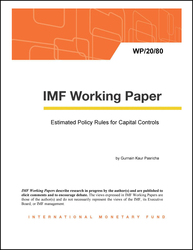
Estimated Policy Rules for Capital Controls
Estimated Policy Rules for Capital Controls
READ MORE...
Volume/Issue:
Volume 2020
Issue 080
Publication date: June 2020
ISBN: 9781513546100
$18.00
Add to Cart by clicking price of the language and format you'd like to purchase
Available Languages and Formats
| English |
Prices in red indicate formats that are not yet available but are forthcoming.
Topics covered in this book
This title contains information about the following subjects.
Click on a subject if you would like to see other titles with the same subjects.
Exports and Imports , Economics- Macroeconomics , Money and Monetary Policy , WP , capital control , monetary policy , exchange rate , foreign currency , capital controls , macroprudential policy , mercantilist motivations , capital flows , emerging markets , policy rules , mercantilism proxy , mercantilist motivation , inflow control , Fiscal stance , Bank credit , Exchange rates , Foreign currency debt , Global , trade competitor , inflation targeting , inflow side capital control , capital control action , nominal exchange rate , mercantilist concern
Summary
This paper borrows the tradition of estimating policy reaction functions from monetary policy literature to ask whether capital controls respond to macroprudential or mercantilist motivations. I explore this question using a novel, weekly dataset on capital control actions in 21 emerging economies from 2001 to 2015. I introduce a new proxy for mercantilist motivations: the weighted appreciation of an emerging-market currency against its top five trade competitors. This proxy Granger causes future net initiations of non-tariff barriers in most countries. Emerging markets systematically respond to both mercantilist and macroprudential motivations. Policymakers respond to trade competitiveness concerns by using both instruments—inflow tightening and outflow easing. They use only inflow tightening in response to macroprudential concerns. Policy is acyclical to foreign debt; however, high levels of this debt reduces countercyclicality to mercantilist concerns. Higher exchange rate pass-through to export prices, and having an inflation targeting regime with non-freely floating exchange rates, increase responsiveness to mercantilist concerns.
Copyright © 2010 - 2024
Powered by:
AIDC



